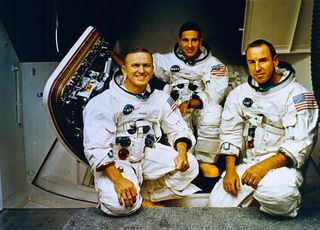55 years after Apollo 8's Christmas at the moon, a new Artemis crew readies for launch (exclusive)
"The systems work! Holy smokes! We can fly around the moon."
NASA's first moon commander in nearly two generations says his crew is thinking a lot about the 55th anniversary of Apollo 8.
Apollo 8, the first human mission to the moon, saw three NASA astronauts launch to lunar realms on Dec. 21, 1968. Frank Borman, Jim Lovell and Bill Anders entered lunar orbit on Christmas Eve (Dec. 24) and did a reading of the opening chapter of the Book of Genesis on live television, before coming back to Earth on Dec. 27.
Only seven months later, NASA had finished Apollos 9 and 10 and the historic, successful debut human landing on July 20, 1969 with Apollo 11. "Once we did Apollo 8," Artemis 2 commander Reid Wiseman recalled, "I think everybody in the United States knew we can land now … the systems work! Holy smokes! We can fly around the moon."
Related: How Apollo 8 morphed into a moon mission (exclusive clip)

Wiseman's Artemis 2 crew plans to run a similar track to Apollo 8 in 2024. Four astronauts will fly around the moon, albeit skipping an orbit this time, and then make their way back to Earth. It's possible that they may be out there in December 2024, given the mission is currently manifested to launch in November 2024. Regardless of when the crew flies, however, the span of time since the last Apollo mission is impressive: Apollo 17 was the last human mission to leave the moon on Dec. 14, 1972, which is 51 years ago this year.
Wiseman said his crew feels parallels with Apollo 8, although a few things are different. Aside from the mission profile, the crew composition includes more diversity: NASA pilot Victor Glover is the first person of color to leave low Earth orbit, NASA mission specialist Christina Koch is the first woman, and Canadian Space Agency mission specialist Jeremy Hansen the first non-American. The greater Artemis program, as Wiseman pointed out, is run internationally under the NASA-led Artemis Accords, unlike Apollo where the agency mostly went on its own.

"It feels to me, with Artemis, we are building more on the International Space Station (ISS), and a long-term presence in space," Wiseman said, pointing to items like hardware and export controls. (That's not an accidental analogy, as the ISS multinational agreements inform the Artemis Accords, and most of the ISS partners are also a part of Artemis.)
Get the Space.com Newsletter
Breaking space news, the latest updates on rocket launches, skywatching events and more!
Artemis, Wiseman said, is not meant to be a new "space race" with another nation like Apollo was at the beginning (even though senior NASA officials repeatedly cite Russia and China as moon-facing space powers they worry about). He also cited NASA's expectations of building a long-term settlement on the moon later in the 2020s or in the early 2030s, to remain indefinitely.
"We don't really have a, 'Before this decade is out,' " Wiseman continued, referring to the goal set by then-President John F. Kennedy in a famous September 1962 speech promising a lunar landing before 1970.
"But we do feel a really robust international team, everywhere we go," Wiseman said. "We try to highlight the Artemis Accords. I think we're up to 33 nations now. To me it feels like it's built on the International Space Station legacy of a little slower, methodical. We're here for the long term."
On the other hand, Wiseman got a special call after his hectic selection on April 3, 2023. The day included a livestreamed announcement at a crowded Ellington Field near NASA's Johnson Space Center, a series of five-minute interviews with media for hours on end, and an NCAA basketball game to start the public relations side of the mission.
"I'm sitting on my couch later that day, completely exhausted," Wiseman recalled. "My cell phone rings. It's an unknown number. I thought it was a telemarketer, and I picked it up all annoyed. It was Tom Stafford, you know, who flew Apollo 10. He was so excited that we were heading back to the moon."
Join our Space Forums to keep talking space on the latest missions, night sky and more! And if you have a news tip, correction or comment, let us know at: community@space.com.

Elizabeth Howell (she/her), Ph.D., is a staff writer in the spaceflight channel since 2022 covering diversity, education and gaming as well. She was contributing writer for Space.com for 10 years before joining full-time. Elizabeth's reporting includes multiple exclusives with the White House and Office of the Vice-President of the United States, an exclusive conversation with aspiring space tourist (and NSYNC bassist) Lance Bass, speaking several times with the International Space Station, witnessing five human spaceflight launches on two continents, flying parabolic, working inside a spacesuit, and participating in a simulated Mars mission. Her latest book, "Why Am I Taller?", is co-written with astronaut Dave Williams. Elizabeth holds a Ph.D. and M.Sc. in Space Studies from the University of North Dakota, a Bachelor of Journalism from Canada's Carleton University and a Bachelor of History from Canada's Athabasca University. Elizabeth is also a post-secondary instructor in communications and science at several institutions since 2015; her experience includes developing and teaching an astronomy course at Canada's Algonquin College (with Indigenous content as well) to more than 1,000 students since 2020. Elizabeth first got interested in space after watching the movie Apollo 13 in 1996, and still wants to be an astronaut someday. Mastodon: https://qoto.org/@howellspace
